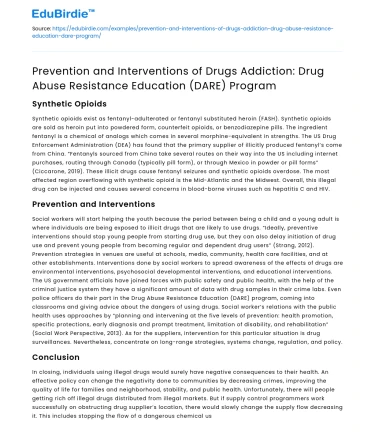Synthetic Opioids
Synthetic opioids exist as fentanyl-adulterated or fentanyl substituted heroin (FASH). Synthetic opioids are sold as heroin put into powdered form, counterfeit opioids, or benzodiazepine pills. The ingredient fentanyl is a chemical of analogs which comes in several morphine-equivalent in strengths. The US Drug Enforcement Administration (DEA) has found that the primary supplier of illicitly produced fentanyl’s come from China. “Fentanyls sourced from China take several routes on their way into the US including internet purchases, routing through Canada (typically pill form), or through Mexico in powder or pill forms” (Ciccarone, 2019). These illicit drugs cause fentanyl seizures and synthetic opioids overdose. The most affected region overflowing with synthetic opioid is the Mid-Atlantic and the Midwest. Overall, this illegal drug can be injected and causes several concerns in blood-borne viruses such as hepatitis C and HIV.
Prevention and Interventions
Social workers will start helping the youth because the period between being a child and a young adult is where individuals are being exposed to illicit drugs that are likely to use drugs. “Ideally, preventive interventions should stop young people from starting drug use, but they can also delay initiation of drug use and prevent young people from becoming regular and dependent drug users” (Strang, 2012). Prevention strategies in venues are useful at schools, media, community, health care facilities, and at other establishments. Interventions done by social workers to spread awareness of the effects of drugs are environmental interventions, psychosocial developmental interventions, and educational interventions. The US government officials have joined forces with public safety and public health, with the help of the criminal justice system they have a significant amount of data with drug samples in their crime labs. Even police officers do their part in the Drug Abuse Resistance Education (DARE) program, coming into classrooms and giving advice about the dangers of using drugs. Social worker’s relations with the public health uses approaches by “planning and intervening at the five levels of prevention: health promotion, specific protections, early diagnosis and prompt treatment, limitation of disability, and rehabilitation” (Social Work Perspective, 2013). As for the suppliers, intervention for this particular situation is drug surveillances. Nevertheless, concentrate on long-range strategies, systems change, regulation, and policy.
Save your time!
We can take care of your essay
- Proper editing and formatting
- Free revision, title page, and bibliography
- Flexible prices and money-back guarantee
Conclusion
In closing, individuals using illegal drugs would surely have negative consequences to their health. An effective policy can change the negativity done to communities by decreasing crimes, improving the quality of life for families and neighborhood, stability, and public health. Unfortunately, there will people getting rich off illegal drugs distributed from illegal markets. But if supply control programmers work successfully on obstructing drug supplier’s location, there would slowly change the supply flow decreasing it. This includes stopping the flow of a dangerous chemical used in drugs known as fentanyl. Many people had seizures and overdosed from the illegal drug. Social workers can help spread the word about the dangers of illegal drugs by speaking in venues at schools, the community, media, healthcare facilities, and other establishments. Furthermore, the US government officials joined together with public safety, public health, and the criminal justice system they can draw out illegal drugs with data from crime labs.






 Stuck on your essay?
Stuck on your essay?

